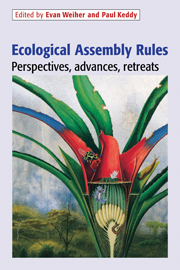Book contents
- Frontmatter
- Contents
- List of Contributors
- Introduction: The scope and goals of research on assembly rules
- Part I The search for meaningful patterns in species assemblages
- Part II Other perspectives on community assembly
- 8 On the nature of the assembly trajectory
- 9 Assembly rules as general constraints on community composition
- 10 A species-based, hierarchical model of island biogeography
- 11 Interaction of physical and biological processes in the assembly of stream fish communities
- 12 Functional implications of trait–environment linkages in plant communities
- 13 When does restoration succeed?
- 14 Epilogue: From global exploration to community assembly
- Index
9 - Assembly rules as general constraints on community composition
Published online by Cambridge University Press: 04 September 2009
- Frontmatter
- Contents
- List of Contributors
- Introduction: The scope and goals of research on assembly rules
- Part I The search for meaningful patterns in species assemblages
- Part II Other perspectives on community assembly
- 8 On the nature of the assembly trajectory
- 9 Assembly rules as general constraints on community composition
- 10 A species-based, hierarchical model of island biogeography
- 11 Interaction of physical and biological processes in the assembly of stream fish communities
- 12 Functional implications of trait–environment linkages in plant communities
- 13 When does restoration succeed?
- 14 Epilogue: From global exploration to community assembly
- Index
Summary
Introduction
It has been more than 20 years since Jared Diamond focused attention on assembly rules for communities (Diamond, 1975), and his three principal questions about community assembly are still topical and largely unsolved. The questions are: (a) To what extent are the component species of a community mutually selected from a larger species pool so as to ‘fit’ with each other? (b) Does the resulting community resist invasion, and if so, how? (c) To what extent is the final species composition of a community uniquely specified by the properties of the physical environment, and to what extent does it depend on chance events? These questions are really about how communities, or assemblages, are selected as subsets of a species pool (Fig. 9.1).
For any region and taxa, one could define a species pool of potential members of an assemblage of species. At the largest scale, this would simply be an exhaustive list of all species (i.e., the flora and fauna), while at smaller scales the pool might be a list of birds, beetles, fish, or plant species that could inhabit a given site or habitat. Communities would be composed of some subset of these smaller lists. Assembly rules are explicitly defined constraints on community structure – in other words, assembly rules set limits on which species can be a part of locally coexisting subsets of the species pool (Fig. 9.1).
- Type
- Chapter
- Information
- Ecological Assembly RulesPerspectives, Advances, Retreats, pp. 251 - 271Publisher: Cambridge University PressPrint publication year: 1999
- 81
- Cited by

